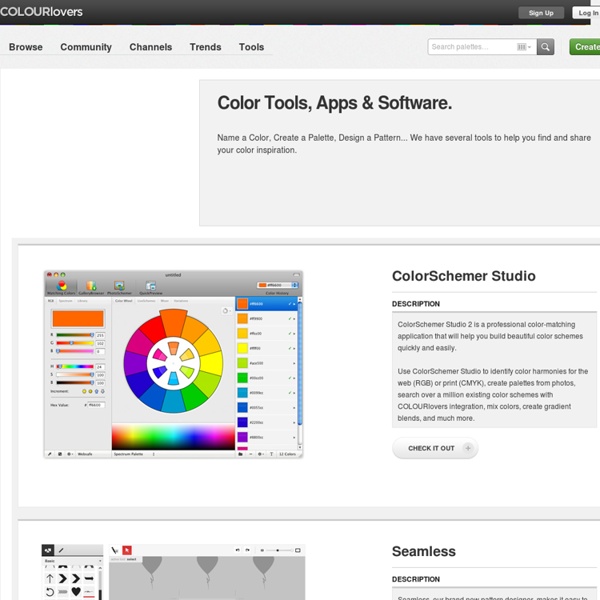



25 Free Color Tools, Apps and Palette Generators The marvelous thing about color within design is you have the choice from an infinite number of possibilities and combinations. On the flip side of that, having infinite color possibilities makes it very difficult to lock down on the perfect color scheme or palette for your project. This is were the post will hopefully help you. In this post we have collected 25 completely free tools, apps and generators to help you find, manage, and create beautiful and, hopefully, perfect color schemes. Color Scheme Designer Color Scheme Designer is very simple to use app that offers you a complete report on how to use any given color (in various combinations as monochromatic, complementary, triadic, analogous, tetradic). Touchan This application is accompanied by a short video tutorial which will allow you to fully utilize all of its features. Kuler Kuler has been built by Adobe, and that is plenty prove its high quality. Colorotate Color Munki Colorsuckr ColorSuckr is awesome! Colorspire ColorJack Infohound
tools | color palette creator v1.6.1 This tool was inspired directly by the excellent Creating Color Palettes article by Andy Clarke. It will create 10 shades of the base color, located top-left, at varying degrees of opacity. The top row emulates opacity over a white background, the bottom over black (or colors of your choosing as of v1.4). The opacity values are 100% opaque, 75%, 50%, 25% and 10% on the top row. The bottom row begins at 85% rather than 100% and continues on as the first. How to use it: Type a valid six character hexidecimal value in the text box above and hit the "ok" button. Hit the "output hex" button to have the table below the palette display hexidecimal color values. Click the "save base" button to write the current base color to a cookie for safe keeping. As of version 1.6, you can export all of your saved palettes to a PNG image by clicking the "create PNG" button in the "saved" window.
Color Palette Generator Color Palette Generator #ffeeff #ffccdd #eeaaaa dull #33aa77 #ffeeee #ffbbdd #ff7799 vibrant URL of image: Make color schemes. If you like this you might also like my logo maker All Tools Biorhythms Business Card Generator Calendars, Printable Swiss Style Color Hunter Color Palette Generator Color Picker Comic Strip Maker Crapola Translator Drawmigo Favicon Generator Flickr RSS Feed Generator Free PDF Cards IMG2TXT Invent-a-Word Landscape Art Bot Logline Library Logoshi Logo Maker Pixel Art Generator Rainbow Words ROT13 Subwords! Reference ASCII Table Current Stamp Price Filler Text & One Liners Jedi Robe Pattern Recipes Special Characters URL Encoded Chars © 1999 - 2024 DeGraeve.com